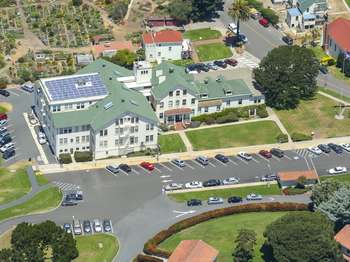Last updated: March 3, 2021
Place
7 - Manifest Destiny

WAYSIDE PANEL TITLE: John Charles Frémont and "Manifest Destiny"
PANEL DESCRIPTION: The wayside faces north and is placed along a cement path that overlooks the bay.
VIEW FROM WAYSIDE: The wayside overlooks the coastal bluffs that descend to the bay below. The view is obscured in some parts by trees, including oaks and palms. Alcatraz Island is straight ahead, characterized by its lighthouse, its large prison, and its water tower. The curve of Municipal Pier is to the right of this scene, and the Marin Headlands stretch along the horizon. To your right, a set of stairs leads to Black Point. Behind you is an open space that may have grass depending on the time of year. The sidewalk continues along bushes and shrubbery to your left.
TEXT: Conflicting Views on Human Worth
TEXT: In 1842, US Army Captain John Charles Frémont led a western expedition to explore and map the Oregon Trail. He would become known as "the Pathfinder," the man who mapped the West. His wife, Jessie Frémont, compiled accounts of his adventures, stirring the nation's fervor for a coast-to-coast empire that was the United States' "Manifest Destiny." This destiny would eradicate the cultures of indigenous peoples across the continent.
During his expeditions, Frémont was responsible for the brutal killing of native peoples, including the slaughter of up to 1,000 Wintu in the Sacramento River area in 1846. Yet John Frémont, who was elected as US Senator from the new state of California, supported numerous bills against the extension of slavery. In 1856, he was selected (over Abraham Lincoln) as the first presidential candidate of the Republican Party, running on an anti-slavery platform.
What are two seemingly contradictory views that you might hold?
DESCRIPTION OF IMAGE: A black-and-white photograph dated 1860 lies adjacent to this text. In it, a woman in a large dark dress and hat stands on a porch and gazes out past the garden to the bay.
CAPTION: Jessie Frémont looks towards Alcatraz from the porch of the home that she shared here with John. The cottage, which stood on the bluff below you, was confiscated by the U S Army during the Civil War to make way for a gun battery.
SIDEBAR: Titled "The Frémonts' Legacies."
DESCRIPTION OF IMAGE: Titled John Charles Frémont (1813 to 1890) and is dated 1860. The illustration depicts a middle-aged John Frémont in a suit and bowtie. He has dark hair that extends past his ears, and a full beard. He looks off to the left.
TEXT: John Frémont gave the Golden Gate its name in 1846. That same year, he assisted American settlers in a revolt against Mexican rule and declared California an independent republic after raising their Bear Flag. He was a Senator and the presidential candidate before serving the Union as a general during the Civil War. But he is most remembered as an explorer of the West.
DESCRIPTION OF IMAGE: Titled "Jessie Benton Frémont (1824 to 1902) and dated 1860. Jessie Frémont wears a large dark dress and sits on the floor as she reads a book. Her hair is pulled back tightly. She is accompanied by an ornate tea set, and the walls of the room are heavily patterned. Ivy encircles the doorway above her head.
TEXT: Jessie Frémont joined John in California in 1849, traveling with their young daughter by ship and crossing Panama. Jessie befriended Reverend Thomas Starr King, a Unitarian minister known for his powerful sermons and advocacy for the rights of free Blacks. At her Black Point home, Jessie invited King to write his fiery abolitionist speeches in her study, and the two hosted literary and political salons with influential figures of the period, including Bret Harte and Herman Melville.
DIRECTIONS TO NEXT WAYSIDE: To reach the next wayside, turn left and walk 63 feet along the cement sidewalk.
